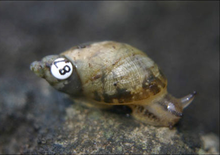Chittenango ovate amber snail
| Chittenango ovate amber snail | |
|---|---|
 |
|
| Right side view of Novisuccinea chittenangoensis. The snail is marked with a number for monitoring the population. | |
| Scientific classification | |
| Kingdom: | Animalia |
| Phylum: | Mollusca |
| Class: | Gastropoda |
| (unranked): |
clade Heterobranchia clade Euthyneura |
| Superfamily: | Succineoidea |
| Family: | Succineidae |
| Subfamily: | Succineinae |
| Genus: | Novisuccinea |
| Species: | N. chittenangoensis |
| Binomial name | |
|
Novisuccinea chittenangoensis (Pilsbry, 1908) |
|
| Synonyms | |
|
|
| Chittenango ovate amber snail | |
| Location map | |
| Coordinates | 42°58′43.45″N 75°50′28.90″W / 42.9787361°N 75.8413611°WCoordinates: 42°58′43.45″N 75°50′28.90″W / 42.9787361°N 75.8413611°W |
|---|---|
|
|
|
clade Euthyneura
clade Panpulmonata
clade Eupulmonata
clade Stylommatophora
clade Elasmognatha
The Chittenango ovate amber snail, scientific name Novisuccinea chittenangoensis, is a species of small air-breathing land snail in the family Succineidae, the amber snails. This species was discovered in 1905, and was reported three years later as a subspecies of the oval ambersnail, Succinea ovalis. Several taxonomic reviews took place in the subsequent decades until the end of the 1980s, when the Chittenango ovate amber snail was finally judged to be a distinct species Novisuccinea chittenangoensis, based on chemical and morphological data.
The Chittenango ovate amber snail is endemic to the Chittenango area of Madison County, New York, United States. There is only one population of this species at Chittenango Falls State Park in central New York, even though it was believed to have a broader range previously; based on fossil records, some authors argue that the distribution of this species may have been much wider in the past. In opposition to this, other authors argue that it is impossible to identify this species based on fossil records, because they only allow for examination of shell features. Shell features of species in this particular family of snails are usually not very distinctive.
Novisuccinea chittenangoensis has a small (an average of 20.9 mm in length in adult individuals), delicate, ovate shell of 3¼ whorls, with deep sutures. The shell is almost translucent, and varies in color from a chalky pale yellow to white, with a glossy surface. Several internal organs of the animal can be distinguished through the shell's outer surface. The visible soft parts of the animal are of a pale subtranslucent yellow color, with different markings during distinct stages of development.
...
Wikipedia


